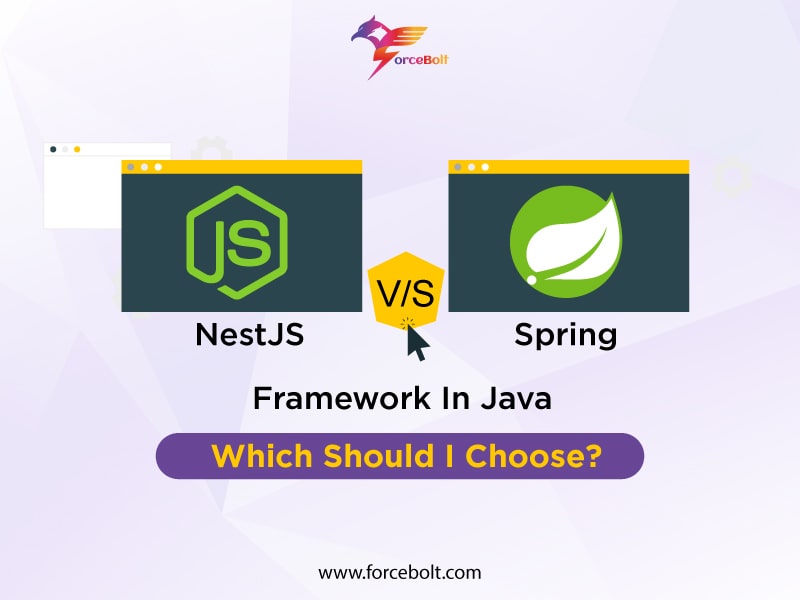Sharing is caring!
It is crucial to compare Spring Framework and NestJS because they are used as the most common frameworks for building web applications. The question of the hour is which one you should choose. The very thing is that you should assess your goals and developmental needs, as each framework has its own set of pros and cons.
The better you assess their qualities, the more or less appealing these frameworks become. This blog will help you understand which one is the right fit for you. Is it NestJS or Spring Framework?
NestJs – An Overview
The progressive Node.js framework is NestJS which is why understanding Node.js is the key here. A low-level I/O API, an event loop, and Google’s V8 JavaScript engine were combined to create Node.js. Developers can use the same solution for both the front-end and the back-end of the applications they make, thanks to the Node.js platform’s server-side runtime environment, which is based on JavaScript.
Node.js is renowned for being highly scalable and super efficient. It allows you to carry out several operations concurrently and is perfect for asynchronous programming.
NestJS is a Node.js framework for building scalable and effective server-side applications, as was already mentioned. It was created with TypeScript and used progressive JavaScript. Object-oriented programming (OOP), functional reactive programming (FRP), and functional programming (FP) are all combined in NestJS. It uses Express internally and supports many other libraries, including Fastify.
NestJS’s primary characteristics that many nest js development companies admire:
- Extensible – Provides developers with a great deal of flexibility by allowing the use of any other libraries.
- Progressive – Uses the most recent JavaScript features and brings many designs to the Node.js world.
- Adaptable: A complete ecosystem that serves as the foundation for all server-side application types.
NestJS has gained 2 times more followers since its introduction in the market than the Spring framework.
Spring Framework – An Overview
Java is a computer platform and programming language. It is renowned for being trustworthy, quick, and secure. It is class-based, object-oriented, and general-purpose to reduce implementation dependencies. One of the most user-friendly programming languages to learn is Java, and once written, its code can run on almost any computing platform. It was created as a multithreaded language with automatic memory management and is platform-independent.
Java’s most popular application development framework is Spring; it is used widely by developers worldwide owing to its high performance, easy testability, and reusable codes. Although Spring can help develop any Java application, many other extensions are available that build web applications on top of the Java EE platform.
Spring is extremely easy to run; it minimizes the hassle of getting applications up and running besides being multithreaded. It is a useful framework for long or relative operations.
Spring’s primary characteristics are:
- Transaction management: Spring offers a consistent interface for managing transactions that can be scaled up to support global transactions or down to support local transactions,
- Lightweight: When compared to EJB containers. For creating and deploying applications on hardware with constrained memory and CPU resources, Spring is useful.
- Dependency injection: Enables the creation of loosely coupled applications, which are simpler to test.
Here’s something you need to keep in mind, you may come across information about Spring Boot which is an extension of the Spring framework. It takes an opinionated view of the spring platform, providing a faster development ecosystem.
NestJS vs. Spring Framework – The Comparison
It’s time for the ultimate comparison when we have understood the core features of both frameworks:
- NestJS: Numerous articles mention NestJS as a flexible and forward-thinking framework that has been greatly influenced by React, Vue, and Angular, which is why nest js development services have taken this framework as their first choice. It is simple to use and makes use of TypeScript. To increase productivity, NestJS also uses a robust command line interface. The dependency injection is also a part of the framework and is well-liked by developers. We can also discuss benefits like:
- Fast and lightweight
- Single-threaded with low utilization of memory
- Growing nmp and JavaScript community
Like many, this framework has some drawbacks too, which are as follows:
- Less support of multi-threading
- Causes performance bottlenecks
- Not ideal for heavy computing
- There’s no strict checking process
- Spring: Java-based application development and testing are frequently made easier with the aid of Spring. It speeds up team productivity and cuts down on development time. It is simple to avoid a lot of boilerplate code, annotations, and XML configuration thanks to Spring Boot. Additionally, the framework offers embedded HTTP servers like Jetty or Tomcat. In addition to that, there are also benefits, including:
- Multiple plugins
- Dependencies that are easy to use
- Multi-threading support
- Manageable and statically-typed Java
There are vast benefits of this framework but below mentioned are a few of the hiccups:
- Includes unused dependencies
- Tough debugging
- Much boilerplate code
- High memory utilization
Conclusion
Now is the time to revisit the query posed at the outset of this article: Which is better for your company: NestJS or Spring Framework? As you probably anticipated, the solution is not simple because it all depends on the product you want to develop. NestJS would be better if you wanted to build a booking system or FinTech application that required a lot of I/O; you can obtain nest js development services from ForceBolt that can guide you through the entire process of creating efficient, reliable, and scalable server-side applications. However, Spring Framework is the best choice if you’re building an application that requires a lot of computation.

Akshay Dhiman
Chief Technical Officer
The Chief Operating Officer of ForceBolt and a decisive leader who possesses a wide array of technical skills and management skills to implement operational changes by working at different levels of development. Being enthusiastic and technology proficient, he understands the importance of staying up-to-date with the latest technological transformations and provides competitive, scalable and efficient solutions. He has a good command of technical language and possesses good communication skills. Being a leader makes him a good team player, and he resonates with his priorities well.













